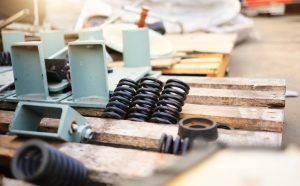Custom wire forms are critical components across a range of industries, providing essential mechanical functionality in a wide variety of assemblies and products. From medical and power generation applications to industrial and electronic uses, wire forms are engineered to meet specific performance needs such as tension, compression, rotational force, or structural support.
In this article, we’ll explore the most common types of custom wire forms, including torsion, tension, flat, and specialty designs, and highlight how their unique shapes and functions impact product design, performance, and manufacturability.

Torsion wire forms are engineered to store and release rotational energy. These parts typically feature coiled sections with straight or bent arms that rotate around a central axis. They work best in applications where parts need to twist and return to their original position.
Common applications include:
Key design considerations:
Torsion wire forms must be precisely manufactured to ensure consistent spring-back performance and to withstand repeated stress without failure—especially critical in high-voltage electrical equipment.
Tension wire forms resist elongation under load and return to their original length once the force is removed. These forms are typically used where components must remain pulled together, yet allow temporary separation or flex.
Typical use cases include:
These wire forms often feature hooks, loops, or custom-fabricated ends for secure mounting. Proper material selection and protective coatings enhance performance in demanding environments like power generation facilities.
Flat wire forms are manufactured by drawing or rolling round wire and are ideal where even pressure distribution and compact design are required. The broader surface contact allows them to act as springs, retainers, or load-distributing supports.
Common functions and uses include:
Flat wire forms offer high stability and reliable elasticity, making them suitable for confined spaces or precision equipment requiring minimal deflection.
Specialty wire forms combine various design elements to perform multifunctional roles. These forms often feature multi-plane bends, integrated hooks or clips, and compound shapes combining torsion, tension, or structural support.
Examples of specialized applications include:
To ensure performance and cost-efficiency, these forms require collaborative prototyping and strict attention to bend tolerances, stress distribution, and material behavior under complex loads.
Custom wire forms are used across critical industries, each demanding specialized performance:
At Ace Wire Spring & Form Co., we support industries from power generation and medical to material handling, mining, railroad, and defense—with USA-made wire forms trusted for performance and durability.
When designing a custom wire form, align the form type with your mechanical and environmental needs:
Understanding torsion, tension, flat, and specialty wire forms helps engineers select the most effective solution for their project. Each form offers specific benefits—from rotational energy delivery to structural support in compact assemblies.
Whether you’re engineering a circuit breaker wire form, developing a medical case handle, or designing a specialized hook for IV bag support, choosing the right manufacturing partner is key.
For precision-engineered, custom wire forms made in the USA, turn to Ace Wire Spring & Form Company. Our experienced team supports you from concept through production with engineering guidance and reliable quality.
Contact Ace Wire Spring & Form Co. today to request a quote or discuss your project needs.
Copyright © Ace WIre Spring & Form Company, Inc. All Rights Reserved. Pittsburgh Website Design by Higher Images.